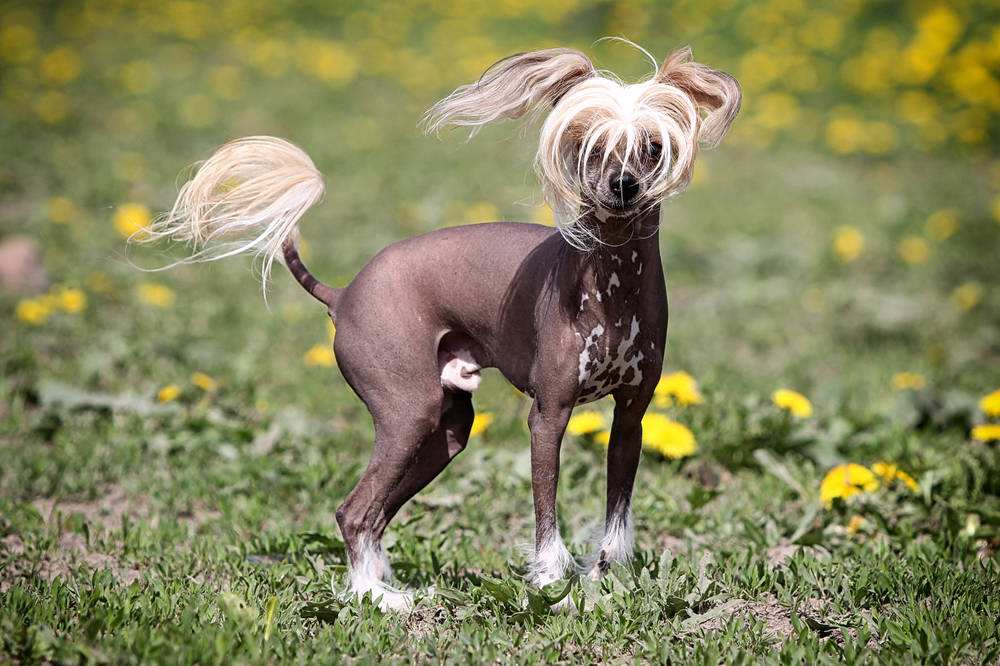Chinese Crested Dog
IUCN
LCBasic Information
Scientific classification
- name:Chinese Crested Dog
- Scientific Name:Chinese Crested
- Outline:Carnivora
- Family:Canidae
Vital signs
- length:23cm
- Weight:3kg
- lifetime:12-15year
Feature
One of the few hairless dog breeds in the world.Lively, clever, brave and gentle. It has the ability to regulate its own body temperature, has a strong ability to adapt to cold and heat, and its body temperature rises immediately after eating.
Distribution and Habitat
The Chinese Crested Dog is mainly produced in China, and is now distributed all over the world. It is mostly raised in large and medium-sized cities such as Beijing, Shanghai, Nanjing, Shenyang, Guangzhou, Nanchang, and Chengdu.
Appearance
The skull is slightly arched from the area between the ears to the back of the skull. The ears are large and erect, uncropped, with the base of the ears in line with the outer corners of the eyes. The cheeks taper to a clear taper to the muzzle. The neck is sloping and clean, slightly arched from the base to the top supporting the head. The forelegs are long, slender and straight. The wrists are upright, delicate and strong. The legs and feet are rabbit-shaped, with narrow and slender feet. The tail is slender, with a slender tip and is long enough to touch the hocks. When the dog is walking, the tail moves merrily or curls over the back.
Details
The Chinese Crested Dog is one of the few hairless dog breeds in the world. It is named Chinese Crested Dog because of the crest on its head, which looks like the hat of Qing Dynasty officials.

There are different opinions about its origin. The Chinese Crested Dog is not a Chinese dog. When naming this dog, Westerners thought that the dog's head crown looked like the hat of a Chinese Qing Dynasty official, so it got the name. There are different opinions about the origin of this dog. Mexican scholars who study dogs believe that the hairless dogs in America came from China, and more specifically pointed out that the time when they were introduced from China to America was 1580-1600. Some believe that it originated from Africa and evolved from the African naked dog; some believe that it came from Turkey and evolved from the Turkish hairless dog; others believe that it was brought by Chinese navigators and sailors during their voyages several centuries ago, and when they stopped at various ports along the way, they traded this dog with port merchants, and thus spread it everywhere. Therefore, this kind of dog has been passed down in various ancient port cities around the world. There are not many Chinese Crested Dogs, but there are still many breeding in the UK and the US, and they are highly regarded by local dog associations and dog clubs. Some zoologists classify Chinese Crested Dogs as African dogs, considering that some hairless mammals come from Africa.
The Chinese Crested is a rare breed of dog, which is of particular interest to geneticists. This dog is hairless, but one pup can be hairy in a litter of puppies born by a mother dog. This hairy pup is considered not purebred and is eliminated. Geneticists have been studying the mystery. This dog is precious because it is rare, and its strange appearance increases its value. It has a hairless body, but a tuft of long hair on its head, which looks very cute.
It is said that for centuries, Chinese sailors took this puppy with them to sea, often selling it to merchants at anchor. When plague broke out, sailors used Chinese Crested dogs to kill pests that spread the plague. Today, this dog can still be found in many ancient port cities around the world.
The American Kennel Club's mixed dog group recognized the Chinese Crested Dog in September 1985; the American Kennel Club officially registered the Chinese Crested Dog on February 1, 1991, and the Chinese Crested Dog began to participate in various dog shows held by the American Kennel Club on April 1, 1991.
Although the Chinese Crested Dog has little hair on its body, it has a strong ability to adapt to the cold and hot climate. According to research, this dog has its own heating system in its body, and the central nervous system can automatically operate to regulate body temperature. Its body temperature is about 2 degrees higher than that of humans, and its body temperature will also rise after eating. It is suitable for keeping company with children and suitable for urban breeding, but not suitable for hot weather. It is difficult to adapt to cold climates and does not need to be combed frequently. The Chinese Crested Dog has sweat glands that can dissipate heat through sweating, while the long-haired type can only dissipate excess body heat by panting, unlike the furry dogs that rely on panting with their tongues out to dissipate heat.
Protect wild animals and eliminate game.
Maintaining ecological balance is everyone's responsibility!








